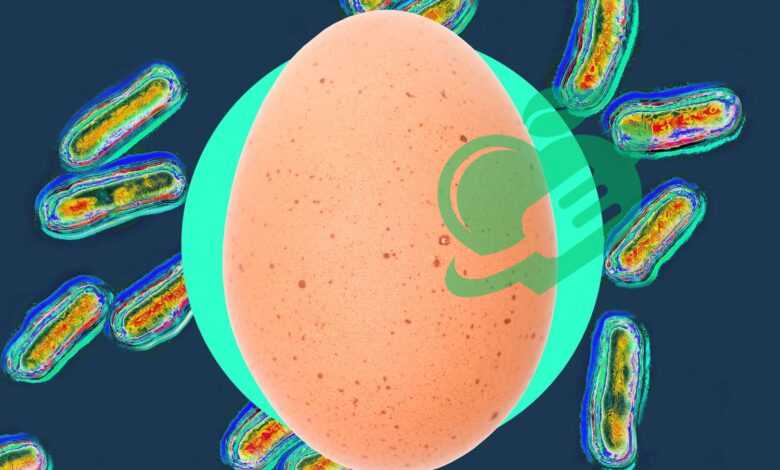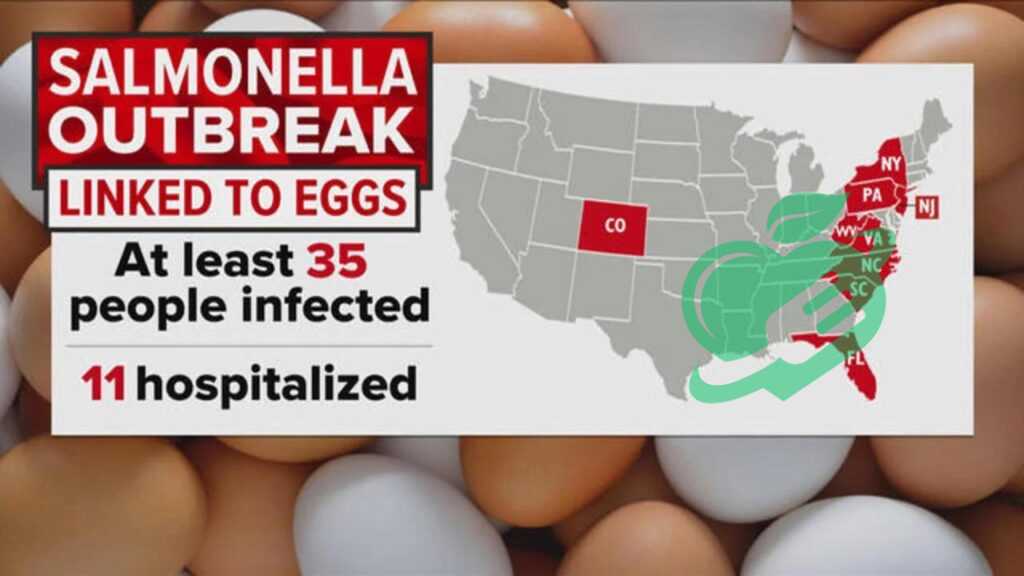Safety First: Stay Updated on the Salmonella Egg Recall

Overview of Salmonella Contamination
Salmonella contamination can cause significant foodborne illness, particularly when it comes to eggs. Many people might not realize that bacteria can reside on the outer shell of a perfectly normal-looking egg or within its contents. The Centers for Disease Control and Prevention (CDC) reports that around 1.35 million infections occur every year due to this microorganism. Personal anecdotes often point to the lack of awareness about how to handle eggs safely. For instance, a family might whip up a delicious omelet, but if they leave the eggs unrefrigerated for too long or don’t wash their hands after handling them, they could easily cause illness. Salmonella primarily spreads through:
- Undercooked or raw eggs
- Contaminated surfaces and equipment
- Improper food handling practices
Being aware of how salmonella contaminates food allows individuals to take necessary precautions.
Details of the Egg Recall Incident
In recent news, the FDA announced egg recalls linked to a significant salmonella outbreak, prompting widespread concern among consumers. 1The details unfolded as specific brands and batch numbers were identified as potential sources of contamination. In some instances, the affected eggs were linked directly to farms where testing confirmed the presence of salmonella enteritidis. The FDA upgraded the egg recall linked to the salmonella outbreak to inform the public about the urgency of the situation. Key elements of the recall included:
- Date of the recall announcement
- Batch numbers and brands of the affected eggs
- Recommendations on what to do if consumers had purchased these eggs
Consumers were urged to check their refrigerators and pantries, throwing away any eggs matching the recall details. It’s crucial to stay informed, as these recalls can significantly impact food safety and health. By being vigilant and following the guidelines provided by health authorities, individuals can protect themselves and their families from foodborne illnesses. Overall, understanding the risks associated with salmonella contamination emphasizes the importance of food safety practices in everyday life.
Read also: Satisfy Your Cravings: 20 Healthy Snacks That Won’t Sabotage Your Diet

Health Risks Associated with Salmonella
When it comes to salmonella contamination, the health risks can be quite alarming. For many people, the thought of undercooked eggs results in a slight shudder; however, the reality is that salmonella can lead to severe illness, especially in vulnerable populations. According to the CDC, young children, older people, pregnant women, and anyone with a compromised immune system if exposed, are at the highest risk for serious complications. Salmonella infections can cause a range of health issues, including:
- Gastroenteritis: Inflammation of the stomach and intestines which can cause diarrhea, abdominal cramps, and fever.
- Dehydration: Resulting from persistent vomiting or diarrhea, which can be particularly dangerous for children and older adults.
- Long-term complications: Rarely, salmonella can lead to reactive arthritis or more serious infections that spread to the bloodstream.
Personal stories abound regarding how quickly a fun family gathering can turn into a nightmare if food safety isn’t taken seriously. A friend of mine once hosted a brunch with friends who enjoyed a delightful egg dish but later found out that the eggs were part of a recall linked to a salmonella outbreak. Thankfully, no one got sick, but it was a sobering reminder of the importance of being informed.
Symptoms of Salmonella Infection
Recognizing the symptoms of a salmonella infection is crucial for early intervention and treatment. Symptoms can appear anywhere from 6 hours to 6 days after exposure and may last between 4 to 7 days. Some common symptoms include:
- Diarrhea: Often severe and sometimes bloody.
- Abdominal cramps: These can vary in intensity and often accompany diarrhea.
- Fever: A mild to moderate fever is typical.
- Nausea and vomiting: Not everyone will experience vomiting, but it’s a common symptom.
Here’s a quick summary table to illustrate the time frame and common symptoms:
| Symptom | Onset Time |
|---|---|
| Diarrhea | 6-72 hours after |
| Abdominal cramps | 6-72 hours after |
| Fever | 6-72 hours after |
| Nausea/Vomiting | 6-72 hours after |
If someone suspects they have contracted salmonella, it’s crucial to seek medical advice, especially if symptoms persist or worsen. Being informed about the dangers of salmonella contamination can help individuals make better food safety choices and ensure the well-being of their families.
Read also:E. Coli Outbreak Update: Carrot Products Recalled

How to Identify Contaminated Eggs
Tips for Checking Egg Safety
In light of the dangers associated with salmonella contamination, being able to identify safe eggs is essential. Here are some helpful tips for checking egg safety before you use them:
- Check the expiration date: Always look for the sell-by or expiration date on the carton. Fresh eggs can last several weeks beyond the sell-by date, but if they’re approaching that date, it’s best to use them soon.
- Inspect the carton: Before purchasing, examine the egg carton for any signs of damage. Cracks or breaks can allow bacteria to enter and contaminate the egg. If the carton itself looks dirty or damp, consider looking for a different one.
- Perform the float test: This simple test can help determine an egg’s freshness. Fill a bowl with water and gently place the egg inside. If it sinks to the bottom and lays flat, it’s fresh. If it stands upright or floats, it’s best to toss it out, as this indicates spoilage or contamination.
Hands-on experiences can make these tips more memorable. A friend once discovered several floating eggs after performing the test, which prompted a thorough clean-out of her fridge—suddenly becoming a mindful egg handler.
Signs of Spoiled or Contaminated Eggs
Understanding the signs of spoiled eggs can save you from consuming potentially contaminated products. Here are some red flags to watch for:
- Off-putting odor: When you crack an egg, it should have a neutral smell. A sulfur or rotten smell is a clear indicator that the egg is bad and should be discarded immediately.
- Discoloration or unusual textures: Fresh eggs have a clean, uniform appearance. If you notice any unusual discoloration or a runny, cloudy egg white, it’s best to err on the side of caution.
- Shell texture: The shell should be smooth and clean. If you notice a slimy or excessively dirty surface, the eggs might be contaminated.
A personal anecdote illustrates this point well: a family member prepared a delightful breakfast with eggs that smelled off when cracked open. It was an easy decision to throw them out, but it taught everyone about the importance of paying attention to those subtle signs. By being vigilant and aware of these tips and signs, individuals can ensure the eggs they handle are safe and secure, protecting their health and that of their loved ones.
Read also: Discover the Benefits of Vitamin A for Shiny, Healthy Hair

Stay Updated on the Salmonella Egg Recall
In recent times, keeping up with official recall announcements has become crucial for consumers, especially concerning food safety. When the FDA issues a recall for eggs linked to salmonella outbreaks, it can lead to confusion and concern among families looking to protect their health. Official announcements typically provide essential information, including:
- Brand and product information: Names of the affected brands and specific product details, including batch numbers, are shared to help consumers identify what to avoid.
- Consumer instructions: Guidance on what actions to take if you’ve purchased the recalled product, such as disposing of eggs or seeking refunds.
- Health alerts: Warnings about potential symptoms to watch for if you think you may have consumed contaminated eggs.
For example, during the recent salmonella egg recall, many consumers received alerts via email or other channels advising them to check their egg cartons against the provided list of affected products. Just last month, a close friend was notified about the recall through a local news app, prompting her to double-check her fridge and confirm that none of the recalled eggs were in her home.
Reliable Sources for Information
Having reliable sources of information is critical when it comes to food safety. Here are some trusted venues to keep you updated:
- FDA website: The FDA regularly posts updates on recalls and safety alerts. Signing up for email notifications can help you stay informed.
- CDC website: 2. The Centers for Disease Control and Prevention provides vital information about outbreaks, symptoms, and prevention methods related to salmonella.
- Local health department websites: 3. These often feature information specific to your area, including food recalls and health advisories.
- Social media: Follow reliable organizations and health departments on platforms like Twitter and Facebook for real-time updates.
By utilizing these trusted resources, individuals can remain informed about salmonella recalls and better protect themselves and their families. With the plethora of information available today, it’s always worth taking a moment to verify that you’re accessing credible sources. Remaining vigilant not only contributes to personal safety but also promotes broader awareness of food safety issues within communities. Keep those egg cartons in check, and always be ready to stay informed!
Read also: Delicious Avocado Egg Salad in 10 Minutes

Tips for Safe Egg Handling
Ensuring eggs are stored correctly is one of the simplest yet most effective ways to prevent salmonella contamination. Let’s discuss some proper storage guidelines that everyone should follow:
- Refrigerate promptly: Always put eggs in the fridge as soon as you get home from the store. Keeping eggs at a stable temperature reduces the chance of bacterial growth. Ideally, eggs should be stored at or below 40°F (4°C).
- Use the original carton: Keeping eggs in their original carton not only protects them from damage but also helps prevent the absorption of odors and flavors from other foods in the fridge, keeping them fresh for longer.
- Organize your fridge: Store eggs on a shelf rather than the door, which experiences more temperature changes. By placing them in the main body of the fridge, you’re less likely to expose them to temperature fluctuations every time the door is opened.
A personal anecdote comes to mind: I once had a family gathering where a friend brought over a dozen fresh eggs. After he realized he had left them out for a few hours, we all learned the importance of proper storage in an instant, so we kept them in the fridge right away.
Cooking Eggs Safely to Kill Bacteria
Cooking eggs thoroughly is paramount for killing any bacteria that could be present. Here are some tips for safely cooking eggs:
- Cook eggs until firm: Scrambled eggs, poached eggs, and omelets should be cooked until both the yolk and white are firm. Running eggs under hot water isn’t enough; they need a thorough cooking process.
- Use a food thermometer: If you’re cooking dishes that contain eggs, ensure they reach an internal temperature of 160°F (71°C). This temperature is high enough to effectively kill any harmful bacteria present.
- Avoid cross-contamination: Always use separate utensils and surfaces for raw eggs and ready-to-eat foods. Washing hands thoroughly after handling raw eggs also helps prevent the spread of bacteria to other foods.
By following these safe egg-handling tips, you not only protect yourself and your loved ones but also enjoy the deliciousness of eggs worry-free. Sitting down at a breakfast table featuring perfectly cooked eggs feels even more satisfying when you know everyone is safe and healthy!
Reporting Procedures to Health Authorities
Reporting suspected contaminated eggs is essential for maintaining food safety and public health. When consumers take the initiative to inform health authorities about possible contamination, it can lead to swift action, including recalls and preventive measures. Here’s how you can report suspected contaminated eggs:
- Contact local health departments: Most local health departments have hotlines or websites where you can report food safety concerns. It’s as easy as making a quick call or filling out an online form.
- Reach out to the FDA: The Food and Drug Administration (FDA) also welcomes reports of suspected contaminated products. You can file a complaint through their website or by contacting their Consumer Complaint Coordinators.
- Keep records: When reporting suspected contamination, it helps to provide as much detail as possible, including the brand name, expiration date, and any symptoms experienced. This information can assist health officials in their investigation.
A personal experience illustrates this process well: a neighbor discovered an unusual odor coming from a batch of eggs. Upon noticing this, they promptly reported their concerns to their local health department, which led to further investigation of the supplier distributing those eggs. This proactive action potentially prevented others from falling ill.
Read also: Black Seed: The Miracle Cure You Need Toda

Role of Consumer Reports in Ensuring Food Safety
Consumer reports play a crucial role in ensuring food safety by providing valuable insights and guidance to the public. Organizations and platforms, such as Consumer Reports, investigate food safety issues, including outbreaks of salmonella linked to eggs. Here are some ways consumer reports contribute:
- Educating the public: They offer educational articles on how to properly handle and store eggs, as well as tips for recognizing signs of contamination.
- Providing product reviews: Many consumer advocacy groups conduct tests and provide ratings on food products, helping to inform consumers about which brands prioritize safety and quality.
- Raising awareness: Reporting on outbreaks and recalls keeps the public informed about potential risks and evolving health advisories related to food products.
Frequently asked questions
What brands of eggs are being recalled for Salmonella 2025?
The brands that have been recalled are Golden Valley, Compliments, Foremost, IGA, No Name, and Western Family. Salmonella can lead to serious health issues, so it is important to stay informed to mitigate health risks. 4
What food is being recalled in 2025?
| Recall Reason Description | Brand Name(s) | Date |
Undeclared allergen (sesame) | La Fiesta | 01/28/2025 |
Undeclared milk | Fresh Direct | 01/30/2025 |
Undeclared milk. | Shirakiku | 01/28/2025 |
| Product may be contaminated with elevated levels of lead. | Zaarah Herbals 5 | The product may be contaminated with elevated levels of lead. |
Does washing eggs remove Salmonella?
Egg washing can be very effective in eliminating Salmonella Infantis from the surface of the eggshell. However, it also facilitates the possibility of salmonella entering the egg through the shell and membrane. Therefore, it is crucial to ensure that the egg does not become contaminated again after it has been washed. 6
Are 3-minute eggs safe to eat?
The American Egg Board suggests cooking eggs by frying, scrambling, steaming, or poaching them until both the yolk and the white are set. For fried eggs, cook them for 2 to 3 minutes on each side or for 4 minutes in a covered pan. When scrambling eggs, cook them until they are firm all the way through. 7
Why are Japanese eggs safe to eat raw?
In Japan, advanced machines are employed to clean eggs, ensuring that the shells do not crack, while simultaneously inspecting their quality and size and packaging them efficiently. Consequently, the likelihood of salmonella contamination from raw eggs in Japan is greatly minimized. 8
Why are American eggs not safe to eat raw?
There is a significant likelihood that it could cause illness. In the United States, egg producers must wash their eggs with soap, enzymes, or chlorine to eliminate any salmonella bacteria that may be present on the shell. 9
Why do people drink raw eggs instead of cooking them?
Raw eggs are rich in various vitamins, nutrients, and antioxidants. Among these, lutein and zeaxanthin are key antioxidants that help safeguard your eyesight and reduce the risk of eye-related diseases. 10
Can you pasteurize eggs?
To pasteurize in-shell eggs, the entire egg, including the yolk’s center, must reach a temperature of 140°F and maintain that temperature for 3.5 minutes. If the yolk’s center falls below 140°F, the 3.5-minute countdown must start over from the beginning. 11
Your body is a mirror of what you eat, so make your food your source of strength and health. Choose with love and awareness what nourishes your body and soul, and be a friend of nature and its colors on your plate, because proper nutrition is the key to a life full of energy and wellness. Follow us constantly, as we strive to provide more useful articles and reliable information that make a difference in your daily life and help you achieve your health goals.
For medical matters




Beautiful and wonderful article